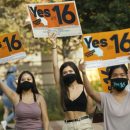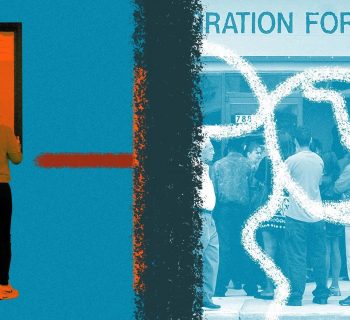BY: Tara Wu, SMITHSONIANMAG.COM –
On a chilly morning in February, about a thousand Chinese immigrants, Chinese Americans and others filled the streets of San Francisco’s historic Chinatown. They marched down Grant Avenue led by a bright red banner emblazoned with the words “Fight the Virus, NOT the People,” followed by Chinese text encouraging global collaboration to fight Covid-19 and condemning discrimination. Other signs carried by the crowd read: “Time For Science, Not Rumors” and “Reject Fear and Racism.”
They were responding to incidents of bias and reported significant drops in revenue in Chinatown and other local Asian American-owned businesses, even at a time when the city had not yet experienced any Covid-19 cases. The rally banner is soon to join the collections of the Smithsonian’s National Museum of American History for the story it tells of America’s history of associating its immigrants with disease.
“There have been long-standing messages about disease being particularly something that Chinese immigrants, Chinese spaces incubate, that Chinese people spread, either because of their unsanitary living conditions or especially the weird, exotic food that Asians allegedly eat,” says Erika Lee, director of the Immigration History Research Center at the University of Minnesota.
/https://public-media.si-cdn.com/filer/74/3f/743fe7dc-e629-4c73-915e-21e4d275def9/img_0387.jpg)
How this phenomenon continues now during the Covid-19 pandemic was recently the subject of a curatorial colloquium called “Fear and Scapegoating during a Pandemic.” The online discussion kicked off Pandemic Perspectives: Stories Through Collections, a twice-monthly online panel discussion organized by the curators and historians at the museum. The series invites audience participation in the examination of objects and images from the collections, using them as a jumping off point for discussions on various aspects of life during the pandemic. Upcoming sessions will focus on such topics as voting, masks, comfort food, essential workers and the race for a vaccine.
“[Fear and scapegoating are] something that emerged right at the beginning of the pandemic, and it’s one of the most pervasive, stubborn kind of myths and prejudices that have emerged,” says Alexandra Lord, medical historian at the museum and the discussion’s moderator. “So we thought it was really important to start by talking about this topic in particular.”
While the virus had only just reached American shores—the day of the San Francisco rally sawAmerica’s first Covid-19 related death in Washington—many Chinese Americans already saw how such terminology as “China virus” intensified an existing anti-Chinese sentiment that would bubble to the forefront of the country’s social conscience.
"We didn’t really shut down as a society until mid-March, yet we see how early Chinese Americans are feeling the impact of the virus, partly because of the history, partly because they are connected transnationally to families and communities in China, but also because the xenophobia that has risen out of Covid-19 was already global before we really experienced the pandemic ourselves,” says Lee, a panelist at the colloquium.
One object discussed was an illustration from the May 26, 1882 issue of the San Francisco Illustrated Wasp, published just weeks after the Chinese Exclusion Act passed. Depicting three ghoulish figures called malarium, smallpox and leprosy and with one holding a sash that says “Chinatown,” the artist’s intent was clear: to suggest that the places Chinese people inhabit spawn disease.
On the cover of an 1899 issue of another mainstream magazine, Judge, U.S. President William McKinley is depicted bathing a Filipino native baby in the “waters of civilization.” In the background, two figures dressing themselves in clothes made from the Puerto Rican flag have presumably just been freshly washed with the same “brush of education” that McKinley holds in his hand. Published during the Spanish-American War just after the U.S. colonized the Philippines and Puerto Rico, the illustration vividly visualizes the racist ideas of the period, according to Theodore Gonzalves, a curator at the museum who specializes in Asian American and performing arts history.
/https://public-media.si-cdn.com/filer/73/1d/731df801-022a-4fd9-8416-3c0ca11b4f86/judge.jpg)
President McKinley is depicted bathing a Filipino native baby in the “waters of civilization.” (NMAH)
“One thing that we're seeing in these images is this idea that it's not just policy that shapes our ideas about immigration, but also, our concept of health, both at a policy level and in terms of medical inspections and also at a cultural level in the stories we tell about race,” said panelist Natalia Molina, a professor of American Studies and Ethnicity at the University of Southern California.
The popular narratives about race have often been tied to differences in physical health and intelligence, as Molina noted after an audience member asked about the role of eugenics in shaping these stories. Lee pointed to the Ku Klux Klan and its reliance on myths of physical and mental disparities between races as a method of enforcing racial segregation and white supremacy, to maintainan “America for Americans.”
In another context, purported differences in physical constitution encouraged agricultural and railroad construction employers to hire Mexicans. Molina explained that people in the United States believed Mexicans to be biologically different: their bodies, it was said, could withstand 110-degree Fahrenheit heat better and produce more work in the fields. But when the Great Depression rolled around, those same workers became economic scapegoats, and characterized as immigrants who were taking jobs away from native-born Americans. During this period, racist notions created the medical myth that portrayed Mexican workers as more susceptible to diseases like tuberculosis and led to charges that they would burden the nation’s healthcare system.
/https://public-media.si-cdn.com/filer/87/f8/87f8d6f2-b04f-4d68-9c11-981fc311e722/nad-200401380209.jpg)
Mexican workers (above: at a mobile X-ray unit) were believed to be biologically different: their bodies, it was said, could withstand 110-degree Fahrenheit heat better and produce more work in the fields. (NMAH)
“It doesn't begin with ethnic and racial minorities,” Gonzalves emphasized. “If we go back to the 1790 Naturalization Act, we have to think about how that was a law that equated citizenship with free white persons of good moral character. . . we have to think about who was really identifying and obsessed with identities. It's clearly the founders themselves. . . . Of course it's going to be an obsession, because [America was founded] on stolen land and everything follows from that. So we are following in the great tradition of America, which is to be obsessed with these questions of identity.”
The museum's curators are collecting items that document the Covid-19 pandemic in the U.S., and are asking the public to help decide what objects or images will represent this time to future generations. “It's so important to be documenting the impact of Covid especially on immigrant and refugee communities,” Lee said, noting that these populations of people are disproportionately working in occupations and industries that put them at greater health and economic risk. “As Dr. Molina pointed out, they are essential workers, but they are not treated as essential. . . . And we need to be collecting their stories.”
BY: Tara Wu, SMITHSONIANMAG.COM –







